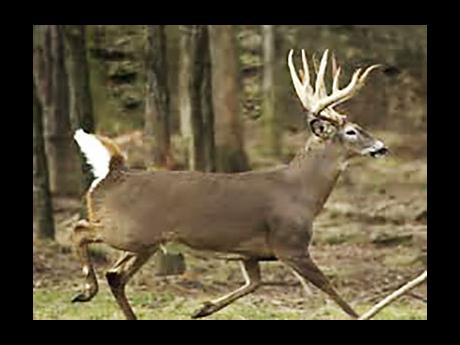Oh deer! - Invasive species reproducing at an alarming rate in eastern Jamaica
Native to the United States, Canada, Mexico, Central America, and South America, the white-tailed deer (Odocoileus virginianus) is emerging as an alien invasive species of major concern here in Jamaica.
"They have no natural predators and are spreading fast, and this is because the food supply is good all year round," terrestrial biologist Damion Whyte told The Sunday Gleaner.
"A very conservative estimate of the population is more than 6,000 in the wild," added Whyte.
Deer have very high rates of reproduction, and given optimum conditions and low mortality rates, their populations can expand rapidly.
Anecdotal evidence shows that these temperate mammals which normally inhabit snow-capped mountains in North America are reproducing in great numbers in Jamaica, as a result of the year-round buffet of lush vegetation, despite a severe drought.
Carrots and pumpkins are among the domestic crops on which they prey the most, causing significant losses for farmers in Portland, with sightings confirmed in the neighbouring parish of St Thomas, as well Stony Hill, St Andrew and elsewhere.
A 2003 investigation conducted by Shauna-Lee Chai, which looked at their distribution, population, and socio-economic impact, showed that the herbivore's habitat was restricted to a 19-kilometre square range in Portland.
Chai identified the communities of Mount Pleasant, Industry, Shrewsbury, Content, Darley, Little Spring Garden, Eden Wood, Paradise, and Swift River as the stamping ground of the deer.
Alarming Grazing Range
Now the threat from the deer, which can cover a grazing range of 30 metres in one day, is cause for concern, with Whyte, a PhD candidate at the University of the West Indies (UWI), Mona campus, pointing out that in North America the doe has a gestation period of 205 days and usually give birth to one fawn, but ideal local tropical conditions are fuelling a population boom.
"We are getting anecdotal evidence of them having two (fawns) the first time they give birth because the food supply is that good and the older ones normally have up to two, but we have records now of people seeing them with three or four fawns.
And all of this is because in North America, they have winter, but here they have an abundance of food and no natural predators," said Whyte, who is also a member of Invasive Alien Species Working Group.
He is convinced that a more targeted approach to culling this alien invasive species is necessary if it is to be brought under control and prevented from wreaking havoc with agriculture, the environment, and livelihoods.
White-tailed deer feed mainly from before dawn until several hours later, and again from late afternoon until dusk. They rest or are inactive during daylight hours. A newborn fawn can stand in 20 minutes, walk one hour after birth, run a bit in 24 hours and outrun a man by the time it is five days old.
Blessed with good eyesight and exceptional hearing, the white-tailed deer are great jumpers, swimmers, and runners, reaching speeds of up to 58 kilometres per hours. In addition, they usually have a sense of smell 1,000 times better than humans and are able to smell people from over a mile away, if the wind is blowing in the right direction.
The National Environment and Planning Agency (NEPA) has given permission for game bird hunters to actively hunt the deer throughout and beyond the 2018 bird shooting season, which started yesterday and runs until Sunday, September 23.
NO HUNTING LIMITS
Unlike the birds, there are no limits on the number of deer which may be hunted or any time restrictions.
However, while NEPA will not be monitoring the deer hunting as it usually does with bird shooting, it will prosecute to the full extent of the law any hunters who pursue the mammal into designated protected areas such as a game reserve, game sanctuary, or forest reserve.
Under the Wild Life Protection Act, offenders convicted in a parish court face a maximum fine of $100,000 or a prison term of up to 12 months.
For this reason, Whyte is urging hunters to aggressively hunt the deer but to stay on the right side of the law.
Farmers familiar with the deer habitat have been acting as tour guides for persons hunting the white-tailed animal, which is a reference to the underside of its tail which it displays and wags whenever it senses danger.


